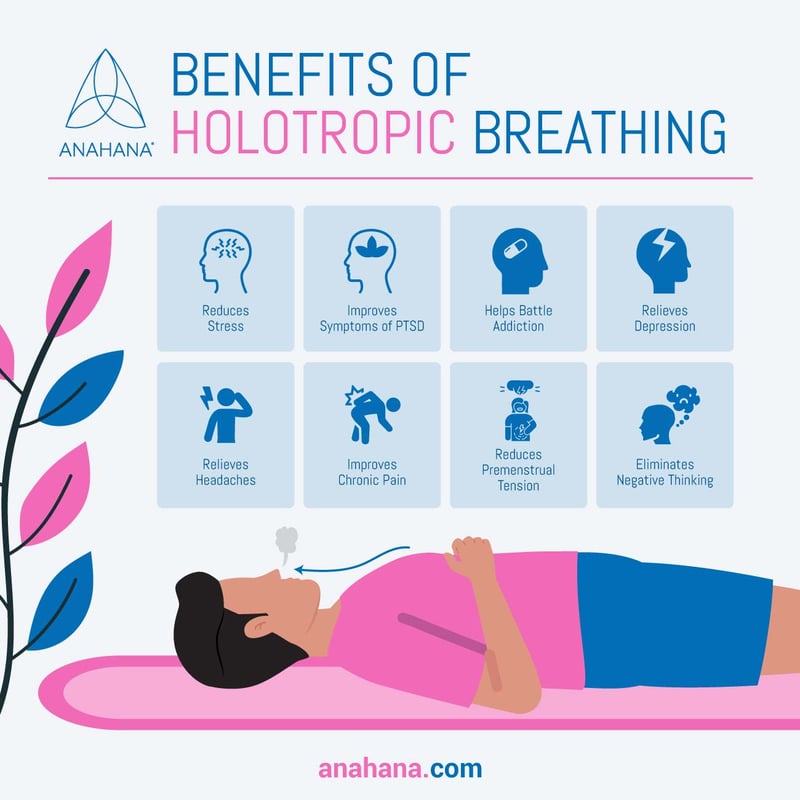
Table of Contents
Holotropic breathing is a therapeutic breathing practice designed to help people with personal and spiritual development by entering into an altered state of mind purely through breathwork. Holotropic breathwork typically takes at least two to three hours and is always accompanied by music.
Holotropic Breathing Explained
Holotropic breathwork is one of the most unique and fascinating breathing techniques. This technique was developed in the 1970s by two psychiatrists, Stanislav and Christina Grof. It's all about using rapid breathing and music to turn your attention inward, open your mind, and find healing. It’s based on modern consciousness research, depth psychology and various spiritual practices.
The word "holotropic" stands for 'moving toward wholeness,' and that's exactly what this practice aims to help you achieve.
Nature of a Holotropic Breathing Session
During a holotropic breathwork session, you'll first engage in a simple but controlled breathing pattern, breathing deeper and faster than usual.
This rapid breathing is a key part of the experience. It's believed to enrich your brain with oxygen and can lead to altered states of consciousness. You'll be lying down, eyes closed, and guided by the rhythm of your breath and the music.
This breathing technique isn't just about the physical act of breathing; it's a gateway to emotional release and unlocking parts of your subconscious.
With practice, some individuals don’t need to alter their breathing for more than a few minutes, as they quickly surrender to the music's flow and the energy expressed through the group. Many people report profound emotional and psychological insights during these sessions.
However, it's important to approach holotropic breathwork with a bit of caution. It's not recommended for everyone, particularly if you have certain health conditions like heart problems, a history of seizures, or severe mental conditions such as schizophrenia.
The intense experience of rapid breathing can be overwhelming physically and emotionally. So, while it's a powerful tool for self-discovery and emotional healing, it's crucial to consider your current health and well-being first.
The Benefits of Holotropic Breathwork Techniques

Holotropic breathwork can be beneficial for the following physical and mental health conditions:
- Stress
- Depression
- Addiction
- Post-traumatic stress disorder
- Avoidance behaviors
- Death anxiety
- Migraine headaches
- Chronic pain
- Asthma
- Premenstrual tension
- Negative thoughts
- Trauma
- High Blood pressure
Many people practice holotropic breathing to work through painful memories and intense emotions, to begin a healing process or for self-exploration.
It can also be beneficial for overall stress relief. During the “high” experienced in holotropic breathing sessions, people see different things, such as images from their past. Because of this, holotropic breathing can be an excellent tool for improving mental health.
Advocates of holotropic breathing have said that it helps find one’s way in life and can assist people in self-discovery and developing self-awareness.
What To Expect During the Session
You can find facilitators that provide breathing practices or, more uncommonly, individual sessions to practice holotropic breathwork.
A trained and certified facilitator leads the session. Participants are asked to pair up, with one person being the “breather” (who lies down on the mat) and the other being the “sitter” (sits and makes sure the breather is safe and comfortable).
The partners will swap positions after they complete a set of actions to let the other partner get their turn.
Sessions usually take two to three hours for each person, after which there are led discussions amongst the group on the individual experiences during the sessions.
Common Experiences
Here are some common types of experiences reported by individuals practicing Holotropic Breathwork:
Intense Sensations
Intense physical sensations such as tingling, vibrations, or warmth throughout the body are experienced. These sensations are often described as energy moving through the body.
Emotional Release
You may experience various emotions, including joy, sadness, anger, fear, or a sense of awe. Emotional catharsis, intense feelings and purging are common aspects of the process.
Altered Perceptions of Time and Space
Many report a distortion of time and space. Time may feel like it is slowing down or speeding up.
Visions and Imagery
Vivid visual experiences, including inner visions, symbolic images, or archetypal symbols. These images can be personal or mythological and may provide insights into the individual's psyche.
Transcendent or Spiritual Experiences
Some individuals describe a connection to a higher power, a feeling of oneness with the universe, or a spiritual awakening. These transcendent experiences can be profound and transformative.
Repressed Memories
Holotropic Breathwork has been associated with the retrieval of repressed or forgotten memories. These memories may be related to past traumas, childhood experiences, or other significant life events.
Physical Manifestations
Participants may exhibit involuntary movements, such as shaking, trembling, or spontaneous body postures. These physical manifestations are considered a natural part of the cathartic process.
Healing and Integration
Many individuals report a sense of a natural inner healing process following Holotropic Breathwork sessions. Insights gained during the experience may contribute to personal growth, self-awareness, altered consciousness, emotional releases and psychological well-being.
Expanded Awareness
Some practitioners describe an expanded or heightened state of awareness, where they feel more attuned to their own inner wisdom, insights, and a deep understanding of their life's purpose.
Integration Challenges
After the intense experiences of Holotropic Breathwork, individuals may face challenges integrating the insights gained into their daily lives. This integration process may require reflection, support, and continued self-care.
Types of Experiences
Stanislav Grof, a psychiatrist and one of the founders of transpersonal psychology, developed the Holotropic Breathwork method based on his extensive research into non-ordinary states of consciousness.
In his framework, he identified different patterns and levels of experiences that individuals might encounter during Holotropic Breathwork. Here are some key ones described by Grof:
- Perinatal Matrices: Grof identified a series of perinatal matrices corresponding to different stages of the birth process. These include the Basic Perinatal Matrix (BPM) I, II, and III. Experiences in these matrices can involve various emotions and sensations related to the birth process, including feelings of constriction, struggle, and liberation.
- Sensory-Motor: This involves releasing and integrating physical and emotional tension stored in the body. Participants may experience sensations such as muscle contractions, vibrations, or shaking. It is often associated with the reliving and resolution of birth-related traumas.
- Biographical: At this level of mind, individuals may revisit and re-experience memories from their personal history, including childhood, adolescence, and adulthood. This matrix commonly involves emotional catharsis and resolving unresolved emotional issues.
- Transpersonal: Individuals may enter transpersonal or spiritual realms beyond the personal and biographical levels. These experiences can include encounters with archetypal images, symbolic landscapes, and a sense of connection to the collective unconscious. The transpersonal level is often associated with mystical or spiritual experiences.
- Void or Cosmic: This domain represents a state of formless, unmanifested consciousness. Individuals may report experiences of emptiness, unity, and a connection to the cosmic or divine. It is often described as a state beyond ordinary egoic identity.
- Archetypal or Collective Unconscious: Individuals may encounter archetypal figures, symbols, and universal themes across cultures and transcend personal experiences. These archetypal experiences can be transformative and may provide profound insights into the nature of existence. They are associated with a sense of connection to humanity.
- Karmic: Grof proposed the existence of a karmic level, where individuals might experience themes related to past lives or collective karma. These experiences can provide insights into unresolved issues carried across lifetimes.
It's important to note that if you’re undergoing Holotropic Breathwork, you may not necessarily move through all these matrices, and the sequence and intensity of experiences can vary. Some people will have different experiences.
How to Perform Holotropic Breathing
It's important to emphasize that holotropic breathing should not be practiced alone. This powerful technique, involving intense and rapid breathing, can evoke profound physical and emotional responses that can be dangerous to navigate without proper guidance.
Therefore, it's crucial to engage in holotropic breathwork only under the supervision of a trained facilitator.
These facilitators are skilled in creating a safe and supportive environment, guiding you through the experience, and helping you process any intense emotions or physical sensations that may arise.
Remember, holotropic breathing is not a substitute for traditional mental health treatments. It can complement existing therapies and breathing exercises, but consult a qualified professional to ensure it aligns with your needs and circumstances.
Music and Holotropic Breathwork
Music plays a crucial role in the practice of Holotropic Breathwork. The carefully selected and curated music enhances the overall experience and facilitates the journey into altered states of consciousness.
Intense music helps grab the participants’ attention at the beginning of the session. There are, traditionally, five phases in holotropic breathwork sessions, and each should have a companion piece:
- Opening music
- Trance-inducing music
- Breakthrough music
- Heart music
- Meditative music
The music used during the session should be unknown to the participants. Avoiding recognizable words and music with a recognized meaning is suggested.
That is because recognizable music may trigger the conscious thinking mind and break the flow of the process and surrender.
Utilizing lesser-known songs that exhibit musical complexity but contain minimal lyrical content is commonly suggested. Examples may include the chants of monks and shamans, instrumental music such as drumming, or religious music intended to facilitate spiritual connection
References
Holotropic Breathwork - Stanislav Grof
Transpersonal Breathwork Practices - Esalen Institute
The Theory and Practice of Holotropic Breathwork® - Holotropic Association Europe
Disclaimer
The contents of this article are provided for informational purposes only and are not intended to substitute for professional medical advice, diagnosis, or treatment. It is always recommended to consult with a qualified healthcare provider before making any health-related changes or if you have any questions or concerns about your health. Anahana is not liable for any errors, omissions, or consequences that may occur from using the information provided.

By: Meriah McCauley
Meriah McCauley is a leading voice in holistic healing, known across North America for her expertise in chakra balancing, spiritual alignment, and energy-based wellness. Her work bridges the art and science of mind-body healing, shaped through years of study, practice, and mentorship. Meriah deepened her understanding of spiritual anatomy and the chakra system under the guidance of her guru, Dr. Don Stapleton, during her immersive training in Costa Rica. She later earned her Master’s degree in Psychology from Columbia University, specializing in Spirituality and the Mind–Body connection, which continues to influence her integrative approach. Today, she supports individuals and practitioners through coaching, yoga teacher trainings, chakra-focused education, and Holotropic Breathwork for personal transformation. Meriah is dedicated to helping others develop emotional clarity, energetic balance, and spiritual resilience—and she remains committed to guiding anyone seeking a deeper, more meaningful connection with themselves.